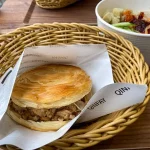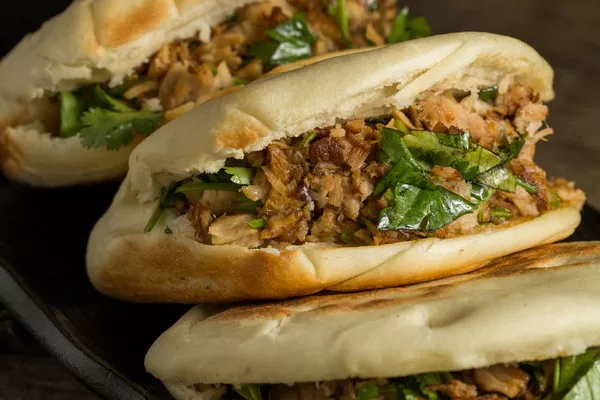Rougamo bread, also known as Chinese meat rougamo or bing, is a flavorful and satisfying delicacy that has been enjoyed for centuries. Originating from Shaanxi province in China, this handheld delight combines a crispy, flaky exterior with succulent, seasoned meat fillings. In this comprehensive guide, we will take you through the step-by-step process of crafting the perfect Rougamo bread, ensuring that your results are nothing short of spectacular.
The Ingredients of Rougamo Bread:
Flour Selection: Rougamo bread starts with the right flour. Opt for high-protein bread flour to achieve the desired texture and structure. This will contribute to a chewy interior and a crisp exterior.
Leavening Agent: Yeast is a key player in the fermentation process, providing the necessary rise and fluffiness to the dough. Active dry yeast or instant yeast are both suitable options.
Water Quality: The quality of water used is often underestimated. Use lukewarm water to activate the yeast effectively, promoting proper fermentation.
Sugar and Salt: Sugar aids in activating the yeast, while salt enhances the overall flavor of the dough. Striking the right balance between these ingredients is crucial for a well-rounded taste.
Oil or Lard: Adding a fat component, such as vegetable oil or lard, contributes to the tenderness of the dough. It also enhances the overall flavor and texture.
Rougamo Bread

Making rougamo bread involves several steps, from preparing the dough to assembling and cooking the final sandwich. Here's a step-by-step guide to help you make delicious rougamo bread at home:
For the Dough:
- 4 cups high-gluten flour
- 1 ½ cups water (adjust as needed)
- 1 teaspoon active dry yeast
- 1 teaspoon sugar
- 1 teaspoon salt
For the Filling:
- 1 lb stewed and seasoned meat (commonly pork or beef)
- Fresh herbs (cilantro, green onions) for garnish
- Spices and seasonings to taste (soy sauce, hoisin sauce, garlic, ginger)
-
In a bowl, combine warm water, sugar, and active dry yeast. Let it sit for 5-10 minutes until it becomes frothy.
-
In a large mixing bowl, combine the high-gluten flour and salt.
-
Gradually add the yeast mixture to the flour while stirring continuously. Once it forms a rough dough, turn it onto a floured surface.
-
Knead the dough for about 10-15 minutes until it becomes smooth and elastic. This process develops the gluten and gives the rougamo its characteristic texture.
-
Place the dough in a lightly oiled bowl, cover it with a damp cloth, and let it rise in a warm place for 1-2 hours or until it doubles in size.
-
Once the dough has risen, divide it into small, golf ball-sized portions.
-
Roll each portion into a thin circle (about 6-8 inches in diameter) on a floured surface. The goal is to achieve a thin, flatbread.
-
Heat a griddle or a large flat pan over medium-high heat. Place the rolled-out dough on the griddle and cook for about 2-3 minutes on each side or until it puffs up and gets golden brown spots.
-
For an extra flaky texture, you can steam the rougamo after griddling. Place the cooked dough in a steamer for 2-3 minutes.
-
Cook your choice of meat (pork or beef) with desired seasonings until tender. Common seasonings include soy sauce, hoisin sauce, garlic, and ginger.
-
Once cooked, shred or chop the meat into smaller pieces.
-
Place a generous amount of the stewed and seasoned meat onto the center of each flatbread. Add fresh herbs such as cilantro and green onions.
Perfecting Your Rougamo:
Texture and Flakiness: Achieving the ideal balance of a crispy exterior and a flaky interior is an art. Experiment with dough thickness, filling quantity, and cooking time to find the perfect combination that suits your taste.
Presentation: The visual appeal of Rougamo bread is as important as its taste. Aim for a golden-brown color on the exterior, indicating a well-cooked and flavorful bread.
Pairing and Serving: Rougamo bread is often enjoyed on its own, but it pairs exceptionally well with various sauces and condiments. Consider serving it with hoisin sauce, chili oil, or a soy-based dipping sauce to enhance the overall experience.
Advanced Techniques: For those seeking to take their Rougamo bread to the next level, consider experimenting with advanced techniques. This may include incorporating additional ingredients into the dough, such as scallions or sesame seeds, to add depth of flavor and texture.
Customizing Fillings: While traditional pork fillings are a staple, don’t be afraid to get creative with your fillings. Explore combinations of different meats, vegetables, or even fusion-inspired options to put your unique twist on this classic dish.
Perfecting the Dough Fermentation: Pay attention to the dough fermentation process. Adjusting the fermentation time can impact the texture and flavor of the bread. Longer fermentation can result in a more complex taste, while shorter fermentation retains a lighter, airier texture.
Temperature and Cooking Equipment: Experimenting with different cooking equipment can yield varied results. Try using a cast-iron skillet for a crispy crust or a griddle for a quicker, more even cook. Adjusting the temperature and cooking time based on your chosen method is crucial for achieving the desired outcome.
Cultural Influences: Embrace the rich cultural history behind Rougamo bread. Learn about regional variations and the diverse ways people enjoy this dish. This knowledge can deepen your appreciation for the craft and inspire you to infuse your personal touch.
Perfecting the Pleating Technique: The art of pleating the edges of the dough is a skill that improves with practice. Pay attention to the thickness of the dough as you pleat, ensuring an even distribution to create a visually appealing and structurally sound bread.
Troubleshooting for Making Rougamo Bread
Here are some common problems and their solutions:
Dough Too Dense:
Issue: If your Rougamo bread turns out too dense, it may be due to over-kneading or insufficient fermentation.
Solution: Adjust the kneading time, ensuring you stop when the dough is smooth and elastic. Additionally, allow the dough to rise adequately during fermentation. Experiment with longer rising times for a lighter texture.
Tough Crust:
Issue: A tough crust can result from cooking at too high a temperature or for too long.
Solution: Lower the cooking temperature or reduce the cooking time. A moderate heat will allow the bread to cook through while maintaining a crispy, yet not overly tough, crust.
Filling Leaks During Cooking:
Issue: If the filling leaks out during cooking, the dough may not be sealed properly.
Solution: Ensure a secure seal by pinching and pleating the edges thoroughly. If using a wet filling, such as one with a lot of marinade, consider slightly thicker dough to prevent leakage.
Uneven Cooking:
Issue: Inconsistent cooking may occur due to uneven dough thickness or temperature fluctuations.
Solution: Roll out the dough to a consistent thickness for even cooking. Additionally, monitor and adjust the cooking temperature as needed. Using a well-preheated cooking surface can also help achieve uniform results.
Bland Flavors:
Issue: If your Rougamo bread lacks flavor, it could be due to insufficient seasoning in the dough or filling.
Solution: Increase the amount of seasoning in both the dough and the filling. Experiment with different spice combinations, ensuring a balance of saltiness, sweetness, and umami for a more robust taste.
Dry Filling:
Issue: A dry filling can result from overcooking or using lean meat without enough fat.
Solution: Choose cuts of meat with slightly higher fat content or add a bit of oil to the filling mixture. Additionally, be mindful of cooking times to prevent the meat from becoming overly dry.
Dough Doesn’t Rise:
Issue: If the dough doesn’t rise properly, it may be due to issues with the yeast or water temperature.
Solution: Ensure your yeast is fresh and activate it in lukewarm water. If the dough still doesn’t rise, your environment may be too cold. Place the dough in a warmer spot or use a slightly warmer water temperature during preparation.
Inconsistent Pleating:
Issue: If the pleating on your Rougamo bread is uneven, it may affect the final appearance.
Solution: Practice your pleating technique to achieve uniformity. Take your time, and make sure the edges are securely sealed. Consistent pleating not only enhances the appearance but also contributes to an even distribution of the filling.
Tips for Storing and Reheating
While rougamo is best enjoyed fresh from the oven, there are occasions when storing and reheating become necessary. Proper storage helps maintain the bread’s texture and flavor, ensuring a delightful experience with each bite.
Storing rougamo in airtight containers or sealed plastic bags prevents it from drying out or becoming stale. When reheating, methods such as steaming or using a damp cloth can revive the bread’s softness. These tips ensure that even leftover rougamo retains its delectable qualities.
Conclusion:
Mastering the art of Rougamo bread requires patience, practice, and a passion for creating exceptional culinary delights. By understanding the nuances of ingredient selection, dough preparation, filling crafting, and cooking techniques, you can elevate your Rougamo-making skills to new heights. Whether you’re a seasoned home cook or a culinary enthusiast looking to explore the world of Chinese cuisine, this comprehensive guide provides the tools and knowledge needed to create Rougamo bread that will impress even the most discerning palates.

